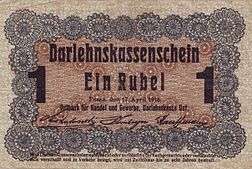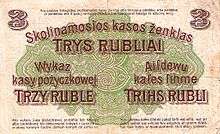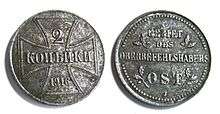German ostruble
Ostruble (German and Polish: Ostrubel; Latvian and Lithuanian: Ostrublis; Russian: Острубль) is the name given to a currency denominated in kopeck and ruble, which was issued by Germany in 1916 for use in the eastern areas under German occupation (Ober Ost and the Government General of Warsaw). It was initially equal to the Russian ruble. The reason for the issue was a shortage of rubles. The banknotes were produced by the Darlehnskasse in Posen (now Poznań) on 17 April 1916.
| German ostruble | |
|---|---|
| Ostrubel (German, Polish) ostrublis (Latvian, Lithuanian) острубль (Russian) | |
 1 Ostruble, 1916 | |
| Denominations | |
| Subunit | |
| 1/100 | kopeck (копѣйка) |
| Plural | The language(s) of this currency belong(s) to the Slavic languages. There is more than one way to construct plural forms. |
| Banknotes | 20, 50 kopecks 1, 3, 10, 25, 100 rubles |
| Coins | 1, 2, 3 kopecks |
| Demographics | |
| Date of introduction | 17 April 1916 |
| Official user(s) | |
| Unofficial user(s) | |
| Issuance | |
| Central bank | Darlehnskasse, Posen |
Circulated alongside German Ostmark, with 2 Ostmarken = 1 Ostruble | |


From 4 April 1918, the Ostrubel circulated alongside the Ostmark in the Ober Ost area, with 2 Ostmarken = 1 Ostrubel. In the Government General of Warsaw the Ostruble was replaced by the Polish marka on 14 April 1917.
Denominations
The denominations available were:
- 20 kopecks;
- 50 kopecks;
- 1 ruble;
- 3 rubles;
- 10 rubles;
- 25 rubles;
- 100 rubles.
The front sides of the banknotes carry a warning in German against forging banknotes. On the reverse sides is the same warning in Latvian (with old style orthography), Lithuanian and Polish.
There were also 1 kopeck, 2 kopeck and 3 kopeck coins, made out of iron.
Aftermath
The Ostrubel circulated in Lithuania together with the Ostmark until 1 October 1922, when it was replaced by the litas.
It was also still in use in a part of the Second Polish Republic during the first months of independence, until 29 April 1920.
References
Bibliography
- Gerhard Hahne, Die Inflation der Markwährungen und das postalische Geschehen im litauisch-polnischen Raum, Forschungsgemeinschaft Litauen im Bund Deutscher Philatelisten e.V., Uetze, (1996) (in German)
- N. Jakimovs and V. Marcilger, The Postal and Monetary History of Latvia 1918–1945, own book, 1991, pp. 14-13–14-15.